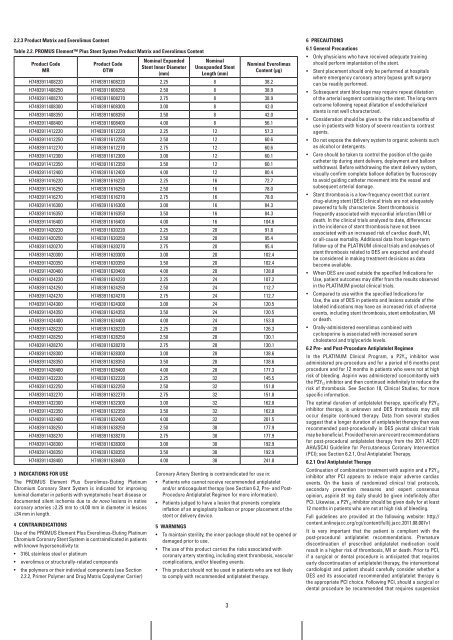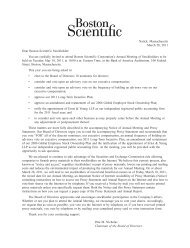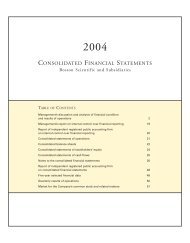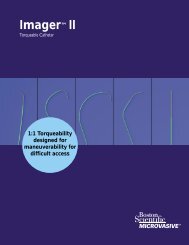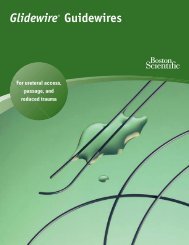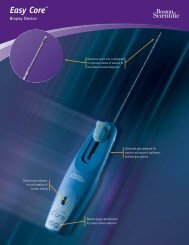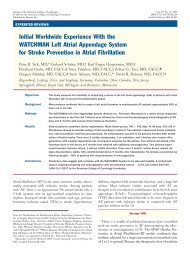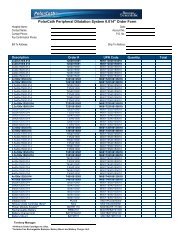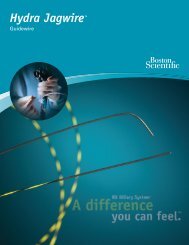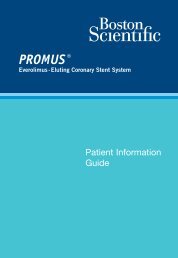PROMUS Element⢠Plus - Boston Scientific
PROMUS Element⢠Plus - Boston Scientific
PROMUS Element⢠Plus - Boston Scientific
You also want an ePaper? Increase the reach of your titles
YUMPU automatically turns print PDFs into web optimized ePapers that Google loves.
2.2.3 Product Matrix and Everolimus Content<br />
Table 2.2. PrOMUS Element <strong>Plus</strong> Stent System Product Matrix and Everolimus Content<br />
Product Code<br />
Mr<br />
Product Code<br />
OTw<br />
nominal Expanded<br />
Stent inner Diameter<br />
(mm)<br />
nominal<br />
Unexpanded Stent<br />
Length (mm)<br />
nominal Everolimus<br />
Content (μg)<br />
H7493911408220 H7493911608220 2.25 8 38.2<br />
H7493911408250 H7493911608250 2.50 8 38.9<br />
H7493911408270 H7493911608270 2.75 8 38.9<br />
H7493911408300 H7493911608300 3.00 8 42.0<br />
H7493911408350 H7493911608350 3.50 8 42.0<br />
H7493911408400 H7493911608400 4.00 8 56.1<br />
H7493911412220 H7493911612220 2.25 12 57.3<br />
H7493911412250 H7493911612250 2.50 12 60.6<br />
H7493911412270 H7493911612270 2.75 12 60.6<br />
H7493911412300 H7493911612300 3.00 12 60.1<br />
H7493911412350 H7493911612350 3.50 12 60.1<br />
H7493911412400 H7493911612400 4.00 12 80.4<br />
H7493911416220 H7493911616220 2.25 16 72.7<br />
H7493911416250 H7493911616250 2.50 16 78.0<br />
H7493911416270 H7493911616270 2.75 16 78.0<br />
H7493911416300 H7493911616300 3.00 16 84.3<br />
H7493911416350 H7493911616350 3.50 16 84.3<br />
H7493911416400 H7493911616400 4.00 16 104.6<br />
H7493911420220 H7493911620220 2.25 20 91.8<br />
H7493911420250 H7493911620250 2.50 20 95.4<br />
H7493911420270 H7493911620270 2.75 20 95.4<br />
H7493911420300 H7493911620300 3.00 20 102.4<br />
H7493911420350 H7493911620350 3.50 20 102.4<br />
H7493911420400 H7493911620400 4.00 20 128.8<br />
H7493911424220 H7493911624220 2.25 24 107.2<br />
H7493911424250 H7493911624250 2.50 24 112.7<br />
H7493911424270 H7493911624270 2.75 24 112.7<br />
H7493911424300 H7493911624300 3.00 24 120.5<br />
H7493911424350 H7493911624350 3.50 24 120.5<br />
H7493911424400 H7493911624400 4.00 24 153.0<br />
H7493911428220 H7493911628220 2.25 28 126.3<br />
H7493911428250 H7493911628250 2.50 28 130.1<br />
H7493911428270 H7493911628270 2.75 28 130.1<br />
H7493911428300 H7493911628300 3.00 28 138.6<br />
H7493911428350 H7493911628350 3.50 28 138.6<br />
H7493911428400 H7493911628400 4.00 28 177.3<br />
H7493911432220 H7493911632220 2.25 32 145.5<br />
H7493911432250 H7493911632250 2.50 32 151.8<br />
H7493911432270 H7493911632270 2.75 32 151.8<br />
H7493911432300 H7493911632300 3.00 32 162.8<br />
H7493911432350 H7493911632350 3.50 32 162.8<br />
H7493911432400 H7493911632400 4.00 32 201.5<br />
H7493911438250 H7493911638250 2.50 38 177.9<br />
H7493911438270 H7493911638270 2.75 38 177.9<br />
H7493911438300 H7493911638300 3.00 38 192.9<br />
H7493911438350 H7493911638350 3.50 38 192.9<br />
H7493911438400 H7493911638400 4.00 38 241.8<br />
3 inDiCaTiOnS fOr USE<br />
The <strong>PROMUS</strong> Element <strong>Plus</strong> Everolimus-Eluting Platinum<br />
Chromium Coronary Stent System is indicated for improving<br />
luminal diameter in patients with symptomatic heart disease or<br />
documented silent ischemia due to de novo lesions in native<br />
coronary arteries ≥2.25 mm to ≤4.00 mm in diameter in lesions<br />
≤34 mm in length.<br />
4 COnTrainDiCaTiOnS<br />
Use of the <strong>PROMUS</strong> Element <strong>Plus</strong> Everolimus-Eluting Platinum<br />
Chromium Coronary Stent System is contraindicated in patients<br />
with known hypersensitivity to:<br />
• 316L stainless steel or platinum<br />
• everolimus or structurally-related compounds<br />
• the polymers or their individual components (see Section<br />
2.2.2, Primer Polymer and Drug Matrix Copolymer Carrier)<br />
Coronary Artery Stenting is contraindicated for use in:<br />
• Patients who cannot receive recommended antiplatelet<br />
and/or anticoagulant therapy (see Section 6.2, Pre- and Post-<br />
Procedure Antiplatelet Regimen for more information).<br />
• Patients judged to have a lesion that prevents complete<br />
inflation of an angioplasty balloon or proper placement of the<br />
stent or delivery device.<br />
5 warningS<br />
• To maintain sterility, the inner package should not be opened or<br />
damaged prior to use.<br />
• The use of this product carries the risks associated with<br />
coronary artery stenting, including stent thrombosis, vascular<br />
complications, and/or bleeding events.<br />
• This product should not be used in patients who are not likely<br />
to comply with recommended antiplatelet therapy.<br />
3<br />
6 PrECaUTiOnS<br />
6.1 general Precautions<br />
• Only physicians who have received adequate training<br />
should perform implantation of the stent.<br />
• Stent placement should only be performed at hospitals<br />
where emergency coronary artery bypass graft surgery<br />
can be readily performed.<br />
• Subsequent stent blockage may require repeat dilatation<br />
of the arterial segment containing the stent. The long-term<br />
outcome following repeat dilatation of endothelialized<br />
stents is not well characterized.<br />
• Consideration should be given to the risks and benefits of<br />
use in patients with history of severe reaction to contrast<br />
agents.<br />
• Do not expose the delivery system to organic solvents such<br />
as alcohol or detergents.<br />
• Care should be taken to control the position of the guide<br />
catheter tip during stent delivery, deployment and balloon<br />
withdrawal. Before withdrawing the stent delivery system,<br />
visually confirm complete balloon deflation by fluoroscopy<br />
to avoid guiding catheter movement into the vessel and<br />
subsequent arterial damage.<br />
• Stent thrombosis is a low-frequency event that current<br />
drug-eluting stent (DES) clinical trials are not adequately<br />
powered to fully characterize. Stent thrombosis is<br />
frequently associated with myocardial infarction (MI) or<br />
death. In the clinical trials analyzed to date, differences<br />
in the incidence of stent thrombosis have not been<br />
associated with an increased risk of cardiac death, MI,<br />
or all-cause mortality. Additional data from longer-term<br />
follow-up of the PLATINUM clinical trials and analyses of<br />
stent thrombosis related to DES are expected and should<br />
be considered in making treatment decisions as data<br />
become available.<br />
• When DES are used outside the specified Indications for<br />
Use, patient outcomes may differ from the results observed<br />
in the PLATINUM pivotal clinical trials.<br />
• Compared to use within the specified Indications for<br />
Use, the use of DES in patients and lesions outside of the<br />
labeled indications may have an increased risk of adverse<br />
events, including stent thrombosis, stent embolization, MI<br />
or death.<br />
• Orally-administered everolimus combined with<br />
cyclosporine is associated with increased serum<br />
cholesterol and triglyceride levels.<br />
6.2 Pre- and Post-Procedure antiplatelet regimen<br />
In the PLATINUM Clinical Program, a P2Y12 inhibitor was<br />
administered pre-procedure and for a period of 6 months post<br />
procedure and for 12 months in patients who were not at high<br />
risk of bleeding. Aspirin was administered concomitantly with<br />
the P2Y12 inhibitor and then continued indefinitely to reduce the<br />
risk of thrombosis. See Section 10, Clinical Studies, for more<br />
specific information.<br />
The optimal duration of antiplatelet therapy, specifically P2Y12 inhibitor therapy, is unknown and DES thrombosis may still<br />
occur despite continued therapy. Data from several studies<br />
suggest that a longer duration of antiplatelet therapy than was<br />
recommended post-procedurally in DES pivotal clinical trials<br />
may be beneficial. Provided herein are recent recommendations<br />
for post-procedural antiplatelet therapy from the 2011 ACCF/<br />
AHA/SCAI Guideline for Percutaneous Coronary Intervention<br />
(PCI); see Section 6.2.1, Oral Antiplatelet Therapy.<br />
6.2.1 Oral antiplatelet Therapy<br />
Continuation of combination treatment with aspirin and a P2Y12 inhibitor after PCI appears to reduce major adverse cardiac<br />
events. On the basis of randomized clinical trial protocols,<br />
secondary prevention measures and expert consensus<br />
opinion, aspirin 81 mg daily should be given indefinitely after<br />
PCI. Likewise, a P2Y12 inhibitor should be given daily for at least<br />
12 months in patients who are not at high risk of bleeding.<br />
Full guidelines are provided at the following website: http://<br />
content.onlinejacc.org/cgi/content/full/j.jacc.2011.08.007v1<br />
It is very important that the patient is compliant with the<br />
post-procedural antiplatelet recommendations. Premature<br />
discontinuation of prescribed antiplatelet medication could<br />
result in a higher risk of thrombosis, MI or death. Prior to PCI,<br />
if a surgical or dental procedure is anticipated that requires<br />
early discontinuation of antiplatelet therapy, the interventional<br />
cardiologist and patient should carefully consider whether a<br />
DES and its associated recommended antiplatelet therapy is<br />
the appropriate PCI choice. Following PCI, should a surgical or<br />
dental procedure be recommended that requires suspension<br />
<strong>Boston</strong> <strong>Scientific</strong>, (Master Brand DFU Template 8.2677in x 11.6929in A4, 90105918AL), eDFU, MB, <strong>PROMUS</strong> Element <strong>Plus</strong>, EN, 90519100-01B


